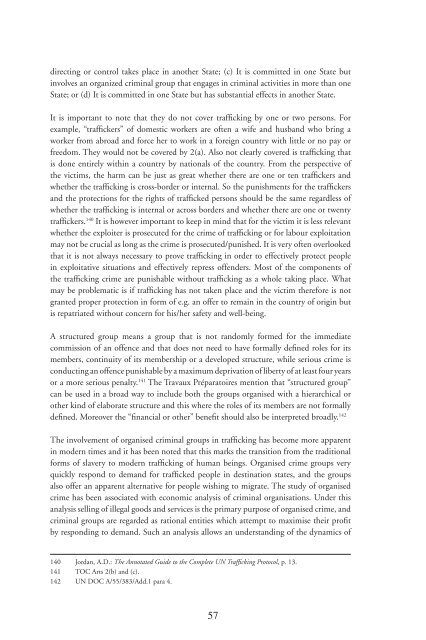Trafficking in human beings: human rights and ... - unesdoc - Unesco
Trafficking in human beings: human rights and ... - unesdoc - Unesco
Trafficking in human beings: human rights and ... - unesdoc - Unesco
Create successful ePaper yourself
Turn your PDF publications into a flip-book with our unique Google optimized e-Paper software.
direct<strong>in</strong>g or control takes place <strong>in</strong> another State; (c) It is committed <strong>in</strong> one State but<br />
<strong>in</strong>volves an organized crim<strong>in</strong>al group that engages <strong>in</strong> crim<strong>in</strong>al activities <strong>in</strong> more than one<br />
State; or (d) It is committed <strong>in</strong> one State but has substantial effects <strong>in</strong> another State.<br />
It is important to note that they do not cover traffi ck<strong>in</strong>g by one or two persons. For<br />
example, “traffi ckers” of domestic workers are often a wife <strong>and</strong> husb<strong>and</strong> who br<strong>in</strong>g a<br />
worker from abroad <strong>and</strong> force her to work <strong>in</strong> a foreign country with little or no pay or<br />
freedom. They would not be covered by 2(a). Also not clearly covered is traffi ck<strong>in</strong>g that<br />
is done entirely with<strong>in</strong> a country by nationals of the country. From the perspective of<br />
the victims, the harm can be just as great whether there are one or ten traffi ckers <strong>and</strong><br />
whether the traffi ck<strong>in</strong>g is cross-border or <strong>in</strong>ternal. So the punishments for the traffi ckers<br />
<strong>and</strong> the protections for the <strong>rights</strong> of traffi cked persons should be the same regardless of<br />
whether the traffi ck<strong>in</strong>g is <strong>in</strong>ternal or across borders <strong>and</strong> whether there are one or twenty<br />
traffi ckers. 140 It is however important to keep <strong>in</strong> m<strong>in</strong>d that for the victim it is less relevant<br />
whether the exploiter is prosecuted for the crime of traffi ck<strong>in</strong>g or for labour exploitation<br />
may not be crucial as long as the crime is prosecuted/punished. It is very often overlooked<br />
that it is not always necessary to prove traffi ck<strong>in</strong>g <strong>in</strong> order to effectively protect people<br />
<strong>in</strong> exploitative situations <strong>and</strong> effectively repress offenders. Most of the components of<br />
the traffi ck<strong>in</strong>g crime are punishable without traffi ck<strong>in</strong>g as a whole tak<strong>in</strong>g place. What<br />
may be problematic is if traffi ck<strong>in</strong>g has not taken place <strong>and</strong> the victim therefore is not<br />
granted proper protection <strong>in</strong> form of e.g. an offer to rema<strong>in</strong> <strong>in</strong> the country of orig<strong>in</strong> but<br />
is repatriated without concern for his/her safety <strong>and</strong> well-be<strong>in</strong>g.<br />
A structured group means a group that is not r<strong>and</strong>omly formed for the immediate<br />
commission of an offence <strong>and</strong> that does not need to have formally defi ned roles for its<br />
members, cont<strong>in</strong>uity of its membership or a developed structure, while serious crime is<br />
conduct<strong>in</strong>g an offence punishable by a maximum deprivation of liberty of at least four years<br />
or a more serious penalty. 141 The Travaux Préparatoires mention that “structured group”<br />
can be used <strong>in</strong> a broad way to <strong>in</strong>clude both the groups organised with a hierarchical or<br />
other k<strong>in</strong>d of elaborate structure <strong>and</strong> this where the roles of its members are not formally<br />
defi ned. Moreover the “fi nancial or other” benefi t should also be <strong>in</strong>terpreted broadly. 142<br />
The <strong>in</strong>volvement of organised crim<strong>in</strong>al groups <strong>in</strong> traffi ck<strong>in</strong>g has become more apparent<br />
<strong>in</strong> modern times <strong>and</strong> it has been noted that this marks the transition from the traditional<br />
forms of slavery to modern traffi ck<strong>in</strong>g of <strong>human</strong> be<strong>in</strong>gs. Organised crime groups very<br />
quickly respond to dem<strong>and</strong> for traffi cked people <strong>in</strong> dest<strong>in</strong>ation states, <strong>and</strong> the groups<br />
also offer an apparent alternative for people wish<strong>in</strong>g to migrate. The study of organised<br />
crime has been associated with economic analysis of crim<strong>in</strong>al organisations. Under this<br />
analysis sell<strong>in</strong>g of illegal goods <strong>and</strong> services is the primary purpose of organised crime, <strong>and</strong><br />
crim<strong>in</strong>al groups are regarded as rational entities which attempt to maximise their profi t<br />
by respond<strong>in</strong>g to dem<strong>and</strong>. Such an analysis allows an underst<strong>and</strong><strong>in</strong>g of the dynamics of<br />
140 Jordan, A.D.: The Annotated Guide to the Complete UN Traffi ck<strong>in</strong>g Protocol, p. 13.<br />
141 TOC Arts 2(b) <strong>and</strong> (c).<br />
142 UN DOC A/55/383/Add.1 para 4.<br />
57

















